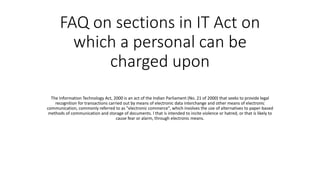
FAQ on sections of IT Act for offenses
- 1. FAQ on sections in IT Act on which a personal can be charged upon The Information Technology Act, 2000 is an act of the Indian Parliament (No. 21 of 2000) that seeks to provide legal recognition for transactions carried out by means of electronic data interchange and other means of electronic communication, commonly referred to as "electronic commerce", which involves the use of alternatives to paper-based methods of communication and storage of documents. l that is intended to incite violence or hatred, or that is likely to cause fear or alarm, through electronic means.
- 2. • Cyberstalking: This refers to the use of electronic means to harass or intimidate someone, such as sending repeated threatening messages or posting personal information online without consent. Identity theft: This refers to the unauthorized use of another person's personal information, such as their name, address, or credit card details, for fraudulent purposes. Cheating by personation using computer resource: This refers to the use of a computer or other electronic device to impersonate someone else, with the intention of defrauding or misleading others.
- 3. • The act applies to the whole of India, and it extends to the whole of India. Under the act, a person can be charged with an offense if they commit any of the following actions: Tampering with computer source documents: This refers to altering or destroying computer source documents, with the intention to cause damage or to conceal any wrongdoing.
- 4. • Damage to computer, computer system, etc: This refers to any action that causes damage to a computer, computer system, or computer network, with the intention to cause harm or disruption.
- 5. • Misuse of encryption: This refers to the unauthorized use of encryption technology, or the possession or distribution of encryption software without a valid license. Publication for fraudulent purpose: This refers to the distribution of false or misleading information through electronic means, with the intention of defrauding or misleading others. It is important to note that these offenses are punishable under the act, and a person found guilty of any of these actions can be imprisoned and/or fined.